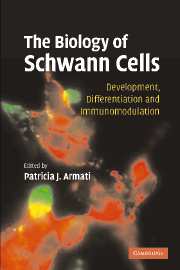Book contents
- Frontmatter
- Contents
- Preface
- Contributors
- 1 Introduction to the Schwann cell
- 2 Early events in Schwann cell development
- 3 The molecular organisation of myelinating Schwann cells
- 4 The role of the extracellular matrix in Schwann cell development and myelination
- 5 The biology of perisynaptic (terminal) Schwann cells
- 6 Cytokine and chemokine interactions with Schwann cells: the neuroimmunology of Schwann cells
- 7 Schwann cells as immunomodulatory cells
- 8 Mutations in Schwann cell genes causing inherited neuropathies
- 9 Guillain–Barré syndrome and the Schwann cell
- 10 Chronic idiopathic demyelinating polyneuropathy and Schwann cells
- References
- Index
- Plate section
8 - Mutations in Schwann cell genes causing inherited neuropathies
Published online by Cambridge University Press: 13 August 2009
- Frontmatter
- Contents
- Preface
- Contributors
- 1 Introduction to the Schwann cell
- 2 Early events in Schwann cell development
- 3 The molecular organisation of myelinating Schwann cells
- 4 The role of the extracellular matrix in Schwann cell development and myelination
- 5 The biology of perisynaptic (terminal) Schwann cells
- 6 Cytokine and chemokine interactions with Schwann cells: the neuroimmunology of Schwann cells
- 7 Schwann cells as immunomodulatory cells
- 8 Mutations in Schwann cell genes causing inherited neuropathies
- 9 Guillain–Barré syndrome and the Schwann cell
- 10 Chronic idiopathic demyelinating polyneuropathy and Schwann cells
- References
- Index
- Plate section
Summary
INTRODUCTION
Charcot–Marie–Tooth disease (CMT) refers to inherited peripheral neuropathies named for three investigators who described them in the late 1800s (Charcot and Marie 1886; Tooth 1886). CMT neuropathies affect approximately one in 2500 people (Skre 1974), and are among the most common inherited neurological disorders. The majority of CMT patients have autosomal dominant inheritance, although X-linked dominant and autosomal recessive forms also exist. Apparent sporadic cases occur, since dominantly inherited disorders may begin as a new mutation in a given patient. The majority of CMT neuropathies are demyelinating, although up to one third appear to be primary axonal disorders. Most patients have a ‘typical’ CMT phenotype characterised by onset in childhood or early adulthood, distal weakness, sensory loss, foot deformities (pes cavus and hammer toes) and absent reflexes. However, some patients develop severe disability in infancy (Dejerine Sottas disease or congenital hypomyelination), while others develop few, if any, symptoms of disease. Thus far at least 30 genes are known to cause inherited neuropathies, and more than 45 distinct loci have been identified. A summary of the genes associated with CMT neuropathies can be found online at http://molgen-www.uia.ac.be/CMTMutations/. Genetic testing for several forms of CMT is now available, which, in addition to providing accurate diagnosis, also provides for genotypic–phenotypic correlations. Progress has been made toward understanding how particular mutations cause disease, but pathogenic mechanisms remain largely unknown.
- Type
- Chapter
- Information
- The Biology of Schwann CellsDevelopment, Differentiation and Immunomodulation, pp. 126 - 157Publisher: Cambridge University PressPrint publication year: 2007



